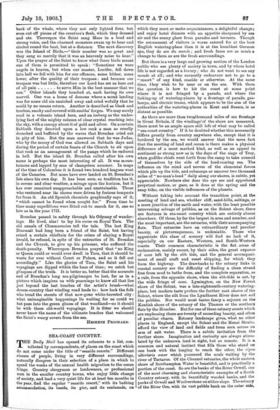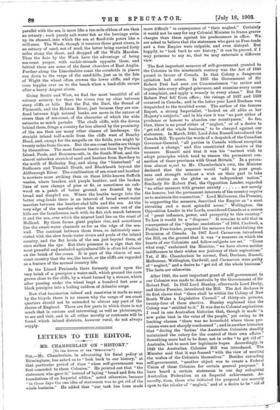SEA-COAST COUNTRY.
THE Daily Mail has opened its columns to a list, con- tributed by correspondents, of places on the coast which do not come under the title of "seaside resorts." Different classes of people, living in very different surroundings, naturally disagree in their selection of a place in which to spend the weeks of the annual health migration to the ocean fringe. Country clergymen or landowners, or professional men in the smaller country towns, who enjoy little change of society, and lead a very quiet life for at least ten months in the year, find the regular "seaside resort," with its bathing accommodation, its bands, its pier, and its esplanade, on which they meet or make acquaintances, a delightful change ; and enjoy hotel dinners with an appetite sharpened by sea air and the sunny glare from parades and terraces. Though the amusement of visitors is worse catered for at the best English watering-place than it is at the humblest German spa, they do see du monde ; and fresh faces are as much a change to them as are the fresh surroundings.
But there is a very large and growing section of the London public who see plenty of society in town, and by whom hotel life is not regarded as a luxury ; who do not want to see any monde at all; and who earnestly endeavour not to go to a " resort " of any kind, seaside or otherwise. At the same time, they wish to be near or on the sea. With them the question is how to hit the coast at some point where it is not fringed by a parade, and where the linking-up of watering-places by a frontage of parade, gas- lamps, and electric trams, which appears to be the aim of the authorities of the watering-places in Kent and Sussex, is as distant as possible.
As there are more than twoRthousand miles of sea frontage in Great Britain, if the windings'of the shore are measured, there must be an ample space still left of what may be called "sea-coast country." If it be doubted whether this necessarily differs greatly from country anywhere else, except that it is bordered by the sea, we would answer that the mere fact that the meeting of land and ocean is there makes a physical difference of a most marked kind, as well as an appeal to sentiment as strong now as in the days of the siege of Troy, when godlike chiefs went forth from the camp to take counsel of themselves by the side of the loud-roaring sea. The influence on the mind and nerves of the elemental forces which pile up the tide, and submerge or uncover two thousand miles of " no-man's-land " daily along our shores, is subtle, yet appreciable. Nowhere else does the eye see and apprehend perpetual motion, or gaze, as it does at the spring and the neap tides, on the visible influences of the planets.
Without taking into account the transition point, at the meeting of land and sea, whether cliff, sand-hills, saltings, or a mere junction of the earth and water, with the least possible intervening selvage of pebbles, as on the Solent shore, there are features in sea-coast country which are entirely absent elsewhere. Of these, by far the largest in area and number, and the most important, are the estuaries, with their accompanying flats. That estuaries have an extraordinary and peculiar beauty, or picturesqueness, is undeniable. Those who appreciate this class of scenery will find no lack of it, especially on our Eastern, Western, and South-Western coasts. Their common characteristic is the flat areas of reclamation, mainly recent, by their sides, the great expanse of ooze left by the ebb tide, and the general accompani- ment of small craft and coast shipping, for which they form the highway. The drawbacks to the estuary links in coastal country are the difficulty of finding a clean strand free from mud to bathe from, and the complete separation, as a rule, from the opposite shore, when the ebb-tide is out, by the wide fringe of ooze. Lymington, on the New Forest shore of the Solent, was a late-eighteenth-century watering- place, but modern taste prefers the further east shores of the Solent, where the silt from the Lyndhurst River does not soil the pebbles. Nor would most tastes fancy a sojourn on the Kentish shore of the estuary of the Thames or the southern flats by the Humber. But for one of these estuary coasts which are unpleasing there are twenty of exceeding beauty, and often of peculiar charm. Estuary landscape gives, what no other places in England, except the Solent and the Menai Straits, afford the view of land and fields and trees seen across an arm of salt water. There is a subtle invitation from the further shore. Imagination and curiosity are always stimu- lated by the unknown land in sight, but so remote. It is a common and natural instinct that fills those who stand on one bank with the longing to reach the other, the ripae alterioris amor which possessed the souls waiting by the river of Tartarus. Of the Channel estuaries, the whole eastern. shore of Southampton Water is beautiful, and is practically a portion of the coast. So are the banks of the River Orwell, one of the most charming and characteristic examples of a South Country estuary, with its beautifully wooded banks, and the parks of Orwell and Woolverstone on either slope. The estuary of the River Ore, with its vast pebble bank on the outer side,
parallel with the sea, is more like a ten-mile ribbon of sea than an estuary; such purely salt-water fish as the herrings swim up its channel, into which the sea at flood-tide pours like a mill-race. The Wash, though it receives three great rivers, is an estuary of sand, not of mud, the latter being carried forty miles along the shore, and dropped off the Wells Marshes. Thus the flats by the Wash have the advantage of being sea-coast proper, with cockle-strands opposite them, and behind them are some of the finest churches of East Anglia. Further along the Lincolnshire coast the cornfields in places run down to the verge of the sand-hills, just as in the Isle of Wight the wheat often crowns the lower cliffs, and ripe corn topples over on to the beach when a land-slide occurs after a heavy August storm.
Going South and West, we find the most beautiful of all estuary scenery, for there the rivers run up clear between steep cliffs or hills. But the Pal, the Dart, the Sound of Plymouth, and the Helston River, just because they are con- fined between high natural banks, are more in the nature of rivers than of sea-coast, of the character of which the wide estuaries so much partake. The chalk cliffs, with the downs behind them, fringe a country far less altered by the proximity of the sea than are many other classes of landscape. Go straight inland half-a-mile from the cliffs west of Beachy Head, and, except for the seagulls on the fields, you might be twenty miles from the sea. But the sea-coast heaths are things by themselves. The most famous tracts are those by Purbeck Island, Poole, and Bournemouth, in the South-West, and the almost unbroken stretch of sand and heather from Bawdsey to the north of Hollesley Bay, and along the " hinterland " of Sudbourn and Tunstall Heath, and Blackheath beyond the Aldborough River. The combination of sea-coast and heather is nowhere more striking than on these little-known Suffolk wastes, where bracken and purple heather, and the broken lines of rare clumps of pine or fir, or sometimes an oak- wood on a patch of better ground, are fronted by the broad and dimpled sea. Where the heaths merge into the better crag-lands there is an interval of broad sweet-water marshes between the heather-clad hills and the sea. At the very edge of the marshes where the waters ooze out of the hills are the farmhouses, each with its flat, rich marsh between it and the sea, over which the nearest land lies on the coast of Holland. By these farms giant poplars rise, and sometimes line the sweet-water channels as far as the edge of the sea- wall. The contrast between these trees, so intimately asso- ciated with the slow fresh-water rivers and pools of the inland country, and the flat levels of the sea just beyond them, at once strikes the eye. But their presence is a sign that the most peaceful an secluded agricultural life is often led almost on the brink of the ocean. It is part of the charm of sea- coast country that the sea, the beach, or the cliffs are regarded as a feature of the normal country life.
In the Lizard Peninsula there formerly stood upon the very brink of a precipice a water-mill, which ground the corn grown close to the cliffs, by a wheel turned by a stream, which after passing under the wheel leapt a hundred feet over a black precipice into a boiling caldron of Atlantic surge.
Now that locomotion inland and coastwise is made so easy by the bicycle there is no reason why the range of sea-coast quarters should not be extended to almost any part of the shores of England. There are few parts in which there is not much that is curious and interesting, as well as picturesque, to see and visit, and in all either novelty or contrasts will be found which inland districts, however rural, do not always supply.











































 Previous page
Previous page